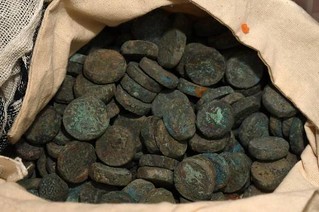
PREV ARTICLE
NEXT ARTICLE
FULL ISSUE
PREV FULL ISSUE
MEDIEVAL COPPER COINS FOUND AT DELHI MOSQUEFound via The Explorator newsletter, this article from The Hindu discusses a chance find of a pot of copper coins at a mosque in Delhi. They're thick pieces - the article likens them to "biscuits." -Editor
Treasure is what the Archaeological Survey of India (ASI) found two months ago in this complex — a hoard of small copper coins vaguely resembling those bite-sized Britannia biscuits from the 90s. A team from ASI’s conservation wing was levelling the ground in early September as part of ongoing conservation work when one of the workers’ pickaxes landed on a mud pot. Work was halted and ASI archaeologists were called. The office was abuzz when they learned about the discovery, says N.K. Pathak, superintending archaeologist, ASI-Delhi circle. “As soon as the coins were discovered, there was a big halla. For archaeologists, discoveries like this are always exciting, no matter the value. Everyone said, Khazana mil gaya!” he says, laughing. Preliminary investigations of the 254 coins reveal that they are from Delhi’s medieval period — 13th to 16th century — the latter part straddling the early modern period. Proper identification can happen only after they are cleaned and studied, says Pathak. “However, some of the coins belong to the reign of Islam Shah Suri.” Islam Shah Suri is the son of Sher Shah Suri, who founded the Sur dynasty and ruled Delhi for seven years from 1538 to 1545. “Most Islamic coins have inscriptions (what we call legends) on them — the name of the ruler and their father’s name. In this case, some of the coins had ‘Islam Shah Suri, son of Sher Shah Suri’ inscribed on them,” says Shahmoon Ahmad, Assistant Archaeologist, ASI-Lucknow circle, who will be studying the coins further. Notably, it was Sher Shah who introduced the precursors to the modern rupee and paise — the silver rupaiya and the copper paisa. The gold coins issued by the Sur dynasty were called mohurs. “Discoveries of gold and silver coins are rather rare. Copper coins are not that much of a surprise,” says Pathak. To read the complete article, see: Wayne Homren, Editor The Numismatic Bibliomania Society is a non-profit organization promoting numismatic literature. See our web site at coinbooks.org. To submit items for publication in The E-Sylum, write to the Editor at this address: whomren@gmail.com To subscribe go to: https://my.binhost.com/lists/listinfo/esylum All Rights Reserved. NBS Home Page Contact the NBS webmaster 
|
